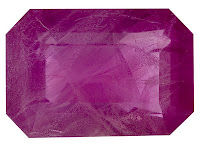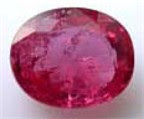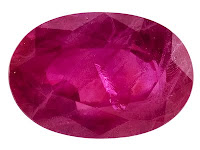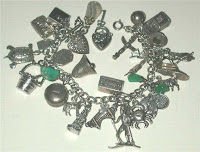In answer to several questions asked recently, YES, there is an abundance of lead-glass filled Rubies on the market being sold without disclosure that the Ruby has been fracture-filled. While the practice of filling small pits and fissures in Ruby with glass has been known for over a decade, the sudden emergence of so many Rubies in the market that are treated this way has raised concerns anew.
.

A True Burma "Mogok" Ruby
.
Rubies and other heat-resistant gems are sometimes treated to conceal surface-reaching fractures, fissures or pits. These pits and fissures are filled with melted flowing glass and then polished over, resulting in a stone with an even, unfractured appearance. Inexperienced buyers who are unaware of the treatment don't look for it and end up paying much more for a stone than it is really worth. Without proper disclosure of the treatment to potential buyers, the practice is considered deceptive. The current treatment seems to be a new variation on a glass theme. The new glass fillings appear to have a lower melting point, which means that natural rutile silk inclusions in Rubies remain unaffected. At higher temperatures, the silk dissolves or partially dissolves, one of the telltale signs the gem has been tampered with. The newly observed gems with glass fillings do not show these characteristics. Most of these type of Rubies are coming from new finds in Africa.
.
Identification via a microscope is nevertheless straightforward for gemologists or trained eyes. Here are some of the clues to look for-----
.

Surface-reaching fissures/fractures – If the stone is examined in reflected light, minute hairline fissures can be observed breaking the surface of the stone. It is through these fissures that glass fillings are introduced. Glass-filled pits may also be observed in reflected light, these areas have a different quality of polish than the surrounding gem.
.
Gas bubbles – By following the path of the fissure and looking into the depths of the gem, glass fillings may be observed. These generally contain rounded gas bubble inclusions. If they are constricted to a smaller fissure, these gas bubbles can become elongated and "squashed" in appearance. As rubies do not have this kind of inclusion in nature, glass filling should be strongly suspected.
.

Flash effect – While the refractive index of the glass and the host ruby may be similar, their dispersion is different. Under magnification, the point of contact of these two substances (glass and ruby) within a fissure often leads to a "flash effect," an optical phenomenon that is manifested in a variety of different colors including violet, purple, blue and green. It can be observed flashing on and off when the gem is rocked and turned under magnification.
.
If any or all of these clues are observed within the stone, it should be rejected as a natural untreated gem, or sent to a laboratory for additional tests. Labs can radiograph a gem, perform sophisticated spectroscope, X-ray fluorescence analysis and other methods for positive identification of glass-filling treatment. The 'Flash effect', can many times be seen by anyone looking at the Ruby under a bright light and rocking it back and forth.
.
It should be noted that the typical "flash-effect" seen in glass-filled Rubies the past few years, may now not be observed in some recent Rubies placed on the market, due to different types of additives being used.
.
And, as a last warning - being sold on eBay, other auction sites and TV are new lab-created Rubies out of Russia and Switzerland. Now, like Alexandrite and other sythetic man-made gems, the old argument become, 'a rose grown outside is the same as a rose grown in a greenhouse', and the same arguement can extend to these sythetic, not simulated, man-made lab-created Rubies. This may be true, but such sythetic stones should be disclosed to the potential buyer as not found naturally. The key to the synthetic Ruby is that it is too clear, to few inclusions and as with synthetic Alexandrite, under high power magnification, you may see the seed stone.
.

A Swiss sythetic lab-created Ruby
.
NOTE: color will vary on each type of screen these are viewed on, so do not depend on the color shown to be an accurate representation.
.
Thanks to Ted Themelis and Lee Little from Thailand for information and pictures on glass-filled Rubies.
.
.









































